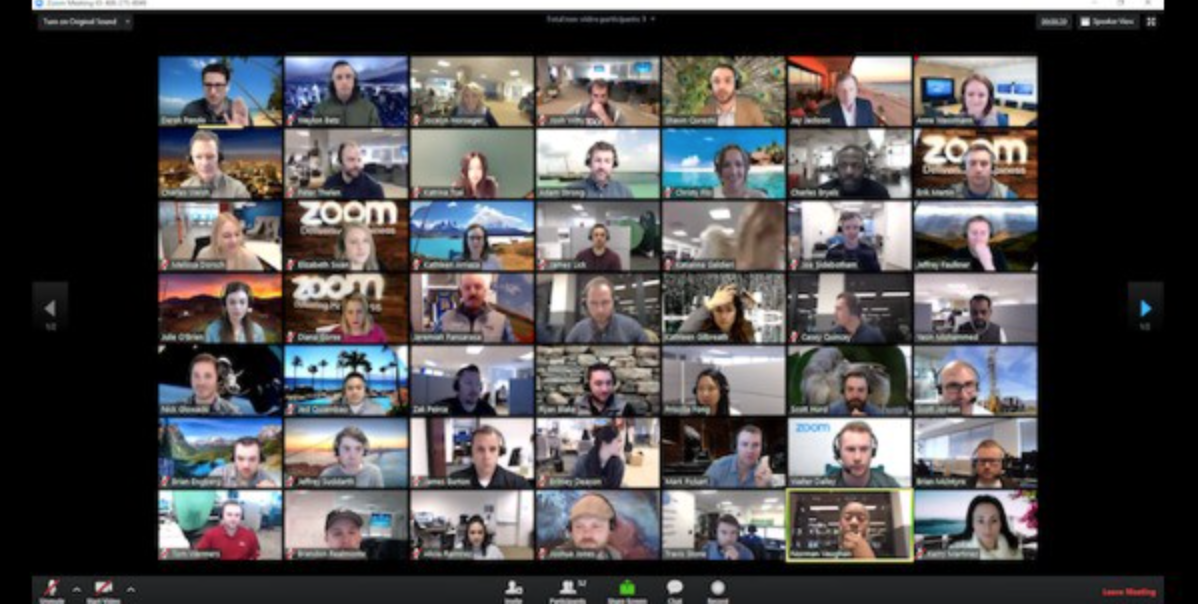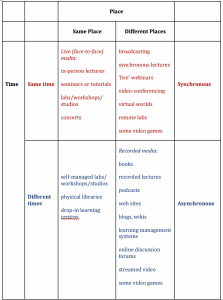Chapter 7: Understanding technology in education
7.4 The time and place dimensions of learning

7.4.1 Key media characteristics
It will help clarify the possible benefits or weaknesses for education of each medium if we understand the characteristics or affordances of each medium. To do this we need to identify where media have common or different features.
There is a wide range of media characteristics or affordances that we could look at, but I will focus on three that are particularly important for education:
- whether media are synchronous or asynchronous, including live (transient) or recorded (permanent);
- whether media are broadcast (one-way) or interactive (two or multiple ways);
- whether media are single or rich.
We shall see that these characteristics are more dimensional than discrete states, and different media will fit at different points on these dimensions, but the exact point on the continua will depend to some extent on the way different media are designed or used. In this section I will focus on the synchronous/asynchronous dimension. The other two characteristics will be discussed in subsequent sections.
7.4.2 Time and space dimensions
Different media and technologies operate differently over space and time. These dimensions are important for both facilitating or inhibiting learning, and for limiting or enabling more flexibility for learners. There are actually two closely related dimensions here:
- ‘live’ or recorded
- synchronous or asynchronous
7.4.2.1 Live or recorded
These are fairly obvious in their meaning. Live media by definition are face-to-face events, such as lectures, seminars, and one-on-one face-to-face tutorials. A ‘live’ event requires everyone to be present at the same place and time as everyone else. This could be a rock concert, a sports event or an in-person lecture.
Live events, such as for instance a seminar, work well when personal relations are important, such as building trust, or for challenging attitudes or positions that are emotionally or strongly held (either by students or instructors.)

The main educational advantage of a live lecture is that it may have a strong emotive quality that inspires or encourages learners beyond the actual transmission of knowledge, or may provide an emotional ‘charge’ that may help students shift from previously held positions. Live events, by definition, are transient. They may be well remembered, but they cannot be repeated, or if they are, it will be a different experience or a different audience. Thus there is a strong qualitative or affective element about live events.
Recorded media, such as a podcast, video-cassette or an audio-cassette, or available to those with permanent access through a streaming service, such as Netflix, YouTube or a university server that records and streams lectures or open educational resources, on the other hand, are permanently available to those possessing the recording. Books and other print formats are also recorded media. The key educational significance of recorded media is that a student can access the same learning material an unlimited number of times, and at times that are convenient for the learner.
Live events of course can also be recorded, but as anyone who has watched a live sports event compared to a recording of the same event knows, the experience is different, with usually a lesser emotional charge when watching a recording (especially if you already know the result). Thus one might think of ‘live’ events as ‘hot’ and recorded events as ‘cool.’ Recorded media can of course be emotionally moving, such as a good novel, but the experience is different from actually taking part in the events described.
7.4.2.2 Synchronous or asynchronous
Synchronous technologies require all those participating in the communication to participate together, at the same time, but not necessarily in the same place.

Thus live events are one example of synchronous media, but unlike live events, technology enables synchronous learning without everyone having to be in the same place, although everyone does have to participate in the event at the same time. A video-conference or a webinar are examples of synchronous technologies which may be broadcast ‘live’, but not with everyone in the same place. Other synchronous technologies are live television or radio broadcasts. You have to be ‘there’ at the time of transmission, or you miss them. However, the ‘there’ may be somewhere different from where the teacher is.
Asynchronous technologies enable participants to access information or communicate at different points of time, usually at the time and place of choice of the participant. All recorded media are asynchronous. Books, DVDs, on-demand You Tube videos, lectures recorded through lecture capture and available for streaming on demand, and online discussion forums are all asynchronous media or technologies. Learners can log on to or access these technologies at times and the place of their own choosing.
Figure 7.4.4 illustrates the main differences between media in terms of different combinations of time and place.

Figure 7.4.4 Synchronous and asynchronous educational media (examples)
7.4.3 Why does this matter?
Synchronous and asynchronous technologies have different advantages and weaknesses (affordances) for teaching and learning.
7.4.3 1 The affordances of asynchronous technologies
Asynchronous technologies have been used in online learning for at least 30 years (and in the case of older media such as books for much longer). Because asynchronous online learning has had to justify itself in comparison with in-person learning, we have more practice- and research-based evidence of the affordances of asynchronous online learning, as well as well-defined quality standards.
Overall there are major educational benefits associated with asynchronous or recorded media, because the ability to access information or communicate at any time offers the learner more control and flexibility. The educational benefits have been confirmed in a number of studies. For instance, Means et al. (2010) found that students in general did better on blended learning than in-person learning, because they spent more time on task, as the online materials were always available to the students.
Research at the UK Open University found that students much preferred to listen to radio broadcasts recorded on cassette than to the actual broadcast, even though the content and format was identical (Grundin, 1981; Bates at al., 1981). However, even greater benefits were found when the format of the audio was changed to take advantage of the control characteristics of cassettes (stop, replay). It was found that students learned more from ‘designed’ cassettes than from cassette recordings of broadcasts, especially when the cassettes were co-ordinated or integrated with visual material, such as text or graphics. This was particularly valuable, for instance, in talking students through mathematical formulae (Durbridge, 1983). The Khan Academy is a more modern approach but using similar principles of using voice over graphics.
This research underlines the importance of changing design as one moves from in-person to asynchronous technologies. Thus we can predict that although there are benefits in recording live lectures through lecture capture in terms of flexibility and access, or having readings available at any time or place, the learning benefits would be even greater if the lecture or text was redesigned for asynchronous use, with built-in activities such as tests and feedback, and points for students to stop the lecture and do some research or extra reading, then returning to the teaching.
The ability to access learning materials on demand (recorded lectures or webinars, learning management systems, web sites, social media) is particularly important for increasing access and flexibility for learners, especially those working as well as studying, for those with young families, or for students with long commutes. Thus there should be clearly justified pedagogical benefits that could not be provided by the use of technology if students must be present either in the same place or at the same time as an instructor. In particular, what are the social or pedagogical reasons why students should come to the school or campus or be present at a set time when so much teaching and learning can now be done asynchronously?
7.4.3.2 The affordances of synchronous technologies
Before the Covid-19 pandemic, there had been little research on the affordances of in-person lectures compared with online teaching. To some extent, in-person lectures or seminars were considered the gold standard. There was no need to identify its advantages over online learning. However, Covid-19 and emergency remote learning resulted in a number of lessons being learned, both about the affordances of lectures in general, and also of the limitations in moving lectures online.
Couey (2022) has set out some of the advantages or affordances of synchronous, in-person learning::
- a dedicated space and time where students and instructors can meet to discuss learning material develops a sense of companionship and can foster an environment conducive to learning
- students are able to discuss complex material together in order to gain a better understanding in real-time, and instructors have a greater finger on the pulse to know what they need to focus on
- students can interrupt the lecture to ask questions which can lead to a more narrow, targeted discussion.
- students can break out into smaller groups to collaborate with each other. Some of the best learning opportunities come from these spontaneous questions and discussions
- teachers can feel the pulse of the room and have a much greater idea about which parts of the lesson students understand and which they might need to spend more time reviewing.
Up until 2019, most online learning was asynchronous, (at least in North America), built around the use of learning management systems. In Canada in 2018, nearly all institutions (93%) were using an LMS for online learning (Johnson, 2019). This suited students who were fully distance learners in particular, who were often also often working full-time, or were at home with young children. Courses were deliberately designed to take advantage of the affordances of asynchronous learning.
However, even before the outbreak of Covid-19, the use of synchronous video-conferencing technologies such as Zoom, Microsoft Teams, BigBlueButton, and so on was increasing rapidly to the point where just over two-thirds of all institutions were also using such synchronous technologies, usually in parallel with an LMS (Johnson, 2019).
In the Spring of 2020, when nearly all post-secondary education was abruptly moved online because of the Covid-19 pandemic, most courses that had not been originally designed for online learning were also moved online. However, because this was an emergency (hence the term emergency remote learning), the main technology used was synchronous video-conferencing for several reasons:
- Instructors were able simply to transfer their familiar in-person lecture methods online.
- The technology was relatively easy to use without extensive training.
- Most institutions already had a license for such technology.
- Lastly, there was no time for instructors to consider re-designing courses.
So during the pandemic, the dominant online teaching method was synchronous lecturing. This did not go down well with students for a number of reasons. The main concerns with synchronous lectures used for emergency remote learning identified from a number of different research studies (Bates, 2021) were as follows:
- too much passive screen time
- too little student interaction either with the instructor or with other students
- work overload, because instructors were often giving students extra work on top of the lectures
- most students preferred to watch the recordings of the lectures but sometimes students were not given access to recordings of the lectures, because the instructor wanted students to be ‘present’ for questions and discussion
- lack of the social aspects that result from being on campus (although this was not really possible anyway during the pandemic).
This suggests the need for a number of adaptations of in-person lectures when moved online:
- probably the most important lesson from the pandemic was that moving classroom lectures online without considerable adaptation is not an effective way to teach.
- some instructors made good use of the break-out rooms in Zoom, for instance, allowing students to have synchronous discussion or do collaborative work, then returning to report to the main session.
- research suggests instructor presentation should be limited to 15 minutes or so followed by a break for questions and discussion.
- it is really important for students to have access to a recording of the lecture.
- lectures should be used in conjunction with asynchronous online activities, such as online discussion forums, online reading or research.
- instructors should carefully consider student workload, especially if combining synchronous and asynchronous learning activities.
- it should be remembered that many students opt for online learning because of its flexibility, which synchronous lecturing considerably retricts.
- online synchronous lectures are not suitable for very large classes because of the difficulty of getting good group interaction with such large numbers. It would be better to record the lecture and arrange for smaller group discussions, either synchronously through Zoom break-out rooms, or (more easily) asynchronously through the learning management system.
All this suggests that, wherever possible, instructors should consider redesigning the whole course if it is to go online, and the rest of the book looks at ways to do this.
7.4.4 Conclusion
The ability to access media asynchronously through recorded and streamed materials is one of the biggest changes in the history of teaching, but the dominant paradigm in higher education is still the live or synchronous lecture or seminar. There are, as we have seen, some advantages in live media, and direct inter-personal contact, but they need to be used more selectively so as to exploit their unique advantages or affordances, and should also be combined with asynchronous media. Indeed, for online learning, asynchronous should be the default model, but supported by synchronous teaching where necessary and appropriate.
References
Bates, A. (1981) ‘Some unique educational characteristics of television and some implications for teaching or learning‘ Journal of Educational Television Vol. 7, No.3
Bates, T. (2021) Research reports on Covid-19 and emergency remote learning/online learning Online Learning and Distance Education Resources, 9 June, 2021
Couey, C. (2022) Distance Learning: Asynchronous vs. Synchronous Learning, Software Advice, March 31
Durbridge, N. (1983) Design implications of audio and video cassettes Milton Keynes: Open University Institute of Educational Technology (out of print)
Grundin, H. (1981) Open University Broadcasting Times and their Impact on Students’ Viewing/Listening Milton Keynes: The Open University Institute of Educational Technology (out of print)
Johnson, N. (2019) Tracking Online Education in Canadian Universities and Colleges: National Survey of Online and Digital Learning 2019 National Report Halifax NS: Canadian Digital Learning Research Association
Means, B. et al. (2010) Evaluation of Evidence-Based Practices in Online Learning: A Meta-Analysis and Review of Online Learning Studies Washington, DC: US Department of Education
Activity 7.4 Time and space dimensions of learning
1. Does this categorization of technologies make sense to you?
2. Can you easily place other media or technologies into Figure 7.4.4? What media or technologies don’t fit? Why not?
3. Write down the (a) advantages and (b) disadvantages of of having some students ‘live’ in the classroom for a lecture and other students participating from home or elsewhere through synchronous streaming of the lecture at the same time. (This is sometimes called ‘bi-modal’ teaching – see Bruff, 2020.)
For my comments on the last question, click on the podcast below:

